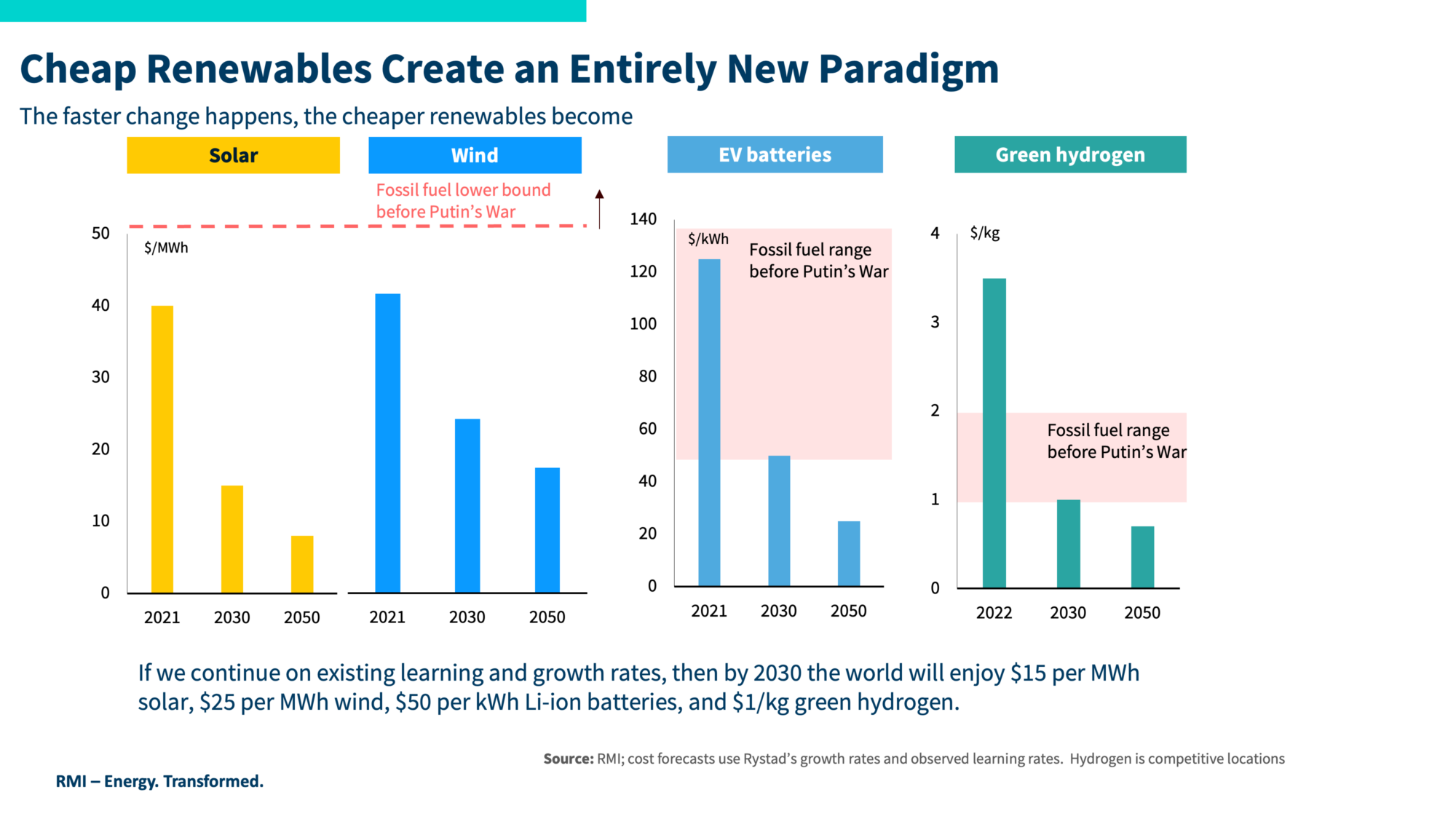The Energy Revolution in 5 Charts

The energy transition is driven by the exponential growth of renewables, and the key changes will happen by 2030.
1. The energy transition is a technology revolution.
At the heart of the energy transition lies the fact that renewable technologies are far superior to fossil fuels. The energy transition is a shift from a concentrated, expensive, polluting commodity-based system with no learning curve, to an efficient, manufactured, technology-driven system that offers continuously falling costs and is available everywhere. It is moving from heavy, fiery molecules to light, obedient electrons; from hunting fossil fuels to farming the sun.
Like past technology shifts, it is a transformation, not merely a substitution. As RethinkX notes, this is not a brown caterpillar to a green caterpillar, but rather a caterpillar to a butterfly, which means different economics, geographies, winners, and energy carriers. Just like past technology shifts, the falling costs of the new render the old obsolete.
Technologies beat commodities.
2. The renewables revolution is exponential, not linear.
When it comes to the renewables revolution, linear is the default perception, but exponential is the default reality. The growth of the key new energy technologies is exponential. It has been in the past, and it will continue to be for the foreseeable future. Companies and countries need to be quick to act, for it is hard to catch an exponential curve from behind.
Exponential is the new normal.
3. The renewables revolution is led by China.
Across manufacturing, deployment, and costs, China is far ahead of the rest of the world. As in past technology shifts, there is a geographical center that disseminates the superior technology around the world. If you wanted to understand the diffusion of the internet, you looked to and modeled the United States. If you want to understand the energy transition, you look to China.
China’s leadership creates a competitive race to the top, which can be seen in recently enacted policies in the United States and Europe.
China is setting the pace of the renewables race.
4. This is the decade of change.
The 2020s are the disruption decade, where renewable technology sales race up the S-curve. If the energy transition were a novel, this decade would be its climax.
The energy system is one of stocks (the bathtub) and flows (the dirty tap and the clean tap). By the end of the decade the clean tap will be on full and the dirty tap will be drying up. Heat pumps, electric vehicles, solar, and wind will all be near the top of their sales S-curves. Once the flow from the tap is clean, the drain (or natural retirement rates) will flush away the fossil system in succeeding decades.
Turn up the clean tap, turn down the noise.
5. By 2030, the debate will be very different.
By 2030, renewables will dominate the sales of energy-producing and consuming technologies. The green prize will be evident. Cheap renewables will be even cheaper. Fossil fuel demand will be off the current plateau and in clear decline. The negative externalities of fossil fuels will be increasingly weaponized. Climate impacts will be more visible. In 2023, it is hard to imagine what this will look like, let alone model it in any detail.
This means we must do as much as we can to narrow our time horizons and focus on speeding up the deployment of key renewables. Four technologies (solar, wind, electric vehicles, and heat pumps), in four markets (China, the United States, the European Union, and India), over the next four years, set the direction. Meanwhile it is vital for other locations and technologies to get onto a similar path.
By 2030, the renewable revolution will be obvious to all.
By Sam Butler-Sloss, Kingsmill Bond
© 2021 Rocky Mountain Institute. Published with permission. Originally posted on RMI website.

Sign up for CleanTechnica's Weekly Substack for Zach and Scott's in-depth analyses and high level summaries, sign up for our daily newsletter, and follow us on Google News!
Whether you have solar power or not, please complete our latest solar power survey.
Have a tip for CleanTechnica? Want to advertise? Want to suggest a guest for our CleanTech Talk podcast? Contact us here.
Sign up for our daily newsletter for 15 new cleantech stories a day. Or sign up for our weekly one on top stories of the week if daily is too frequent.
CleanTechnica uses affiliate links. See our policy here.
CleanTechnica's Comment Policy






